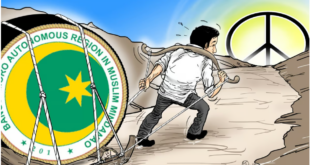A joint sitting of both houses of Parliament is a rare honor previously accorded to US Presidents Barack Obama and George W. Bush and Chinese leader Xi Jinping.

Australia remains a steadfast ally, and in terms of proximity, it has the capability of being the first responder when trouble erupts.
The ties that bind our two nations were welded during the Second World War when it was believed that Japan’s march into the Asia Pacific and the possible invasion of Australia were averted by the fierce resistance of Filipino and American soldiers against the invaders.
A different challenge has emerged amid the friction in the West Philippine Sea, or WPS, in which China’s expansive maritime claims threaten to disrupt regional and even global trade.
The Philippines has been consistently pushing back against China’s aggressive claim to practically the entire body of water between the two nations. This claim was invalidated by a 2016 decision of the United Nations-backed Permanent Court of Arbitration, or PCA.
President Ferdinand Marcos Jr. will address a joint sitting of Australia’s Parliament, which is a rare opportunity for a country leader and is being taken as a sign of the deepening ties between Manila and Canberra.
A joint sitting of both houses of Parliament is a rare honor previously accorded to US Presidents Barack Obama and George W. Bush and Chinese leader Xi Jinping.
Australian Prime Minister Anthony Albanese has prioritized elevating relationships with Indo-Pacific nations, using invitations to speak on Parliament’s floor as a diplomacy tool.
Albanese is paying particular attention to the Philippines due to the maritime conflict with China. He became the first Australian prime minister in 20 years to make a bilateral visit to the Philippines in September 2023.
During his trip, the Australian leader signed an agreement with Mr. Marcos to upgrade both countries’ ties to a strategic partnership.
Marcos will also attend the ASEAN-Australia summit, which will begin in Melbourne on 4 March.
Throughout the Cold War period, the two sides interacted under the shadow of America, which relied on massive military bases across the Philippines to contain communist expansion in Asia.
Shortly after China seized Mischief, or Panganiban, Reef in the WPS in 1995, Manila and Canberra signed a memorandum of understanding on Cooperative Defense Activities.
The MoU laid the groundwork for a Joint Defense Cooperation Committee, which oversaw the implementation of joint military operations.
Following China’s occupation of Scarborough Shoal after a months-long naval standoff with the Philippines in mid-2012, the Philippine Senate overwhelmingly voted in favor of the Status of Visiting Forces Agreement, or SOVFA. SOVFA facilitated Australia’s humanitarian assistance and disaster relief operations after the 2013 supertyphoon “Yolanda” struck Central Visayas, resulting in horrendous deaths that ran into the tens of thousands.
Under SOVFA, Australia’s participation in Philippines-US joint military activities, most notably the annual Balikatan Exercises, has increased.
In 2015, then-Australian Prime Minister Malcolm Turnbull visited Manila, where he signed the Joint Declaration on Australia-Philippines Comprehensive Partnership.
Canberra, shortly after, provided real-time intelligence and offered special forces training to combat militant extremists during the Marawi crisis in the southern Philippines.
A regional ally that is within reach when trouble brews, not only due to geopolitical conflict but also natural calamities, adds to the sense of security of our nation.
Neighbors should mutually reinforce the sense of well-being of their citizens instead of issuing threats and using military muscle to force smaller nations to their knees.
*****
Credit belongs to: tribune.net.ph
 Atin Ito First Filipino Community Newspaper in Ontario
Atin Ito First Filipino Community Newspaper in Ontario






